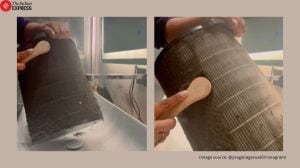Typhoid and hepatitis on the rise after rains and floods: Why early diagnosis is important
The reason why we should attend to disease management quickly by way of blood tests and liver function test (LFT) is because delays cause complications that require hospitalisation, says Dr Rommel Tickoo, Director, Internal Medicine, Max Super Speciality Hospital, Saket, New Delhi
 With drinking water sources contaminated and a breeding ground of Salmonella, food poisoning and typhoid are common manifestations (Source: Freepik)
With drinking water sources contaminated and a breeding ground of Salmonella, food poisoning and typhoid are common manifestations (Source: Freepik) With heavy rains and flood waters rising and receding alternately, the predictable has happened. With flooding, a lot of potable water sources have gotten mixed with waste or sewage water and microbes have leached into fresh water. Our OPDs are full of patients presenting themselves with water-borne diseases, the commonest among them being typhoid. This is a bacterial infection, caused by Salmonella Typhi, that can affect many organs at one go. Without prompt treatment, it can cause serious complications.
SOURCES OF CONTAMINATION
With drinking water sources contaminated and a breeding ground of Salmonella, food poisoning and typhoid are common manifestations. It is best not to drink or eat anything outside your home. Even if you are having mineral water, the food prepared outside your home could be infected with bacteria. You may have a juice or cocktail but the ice could be prepared from infected water. You may be having fresh salads at home too but check if the peels, skin of fruits and vegetables have been thoroughly washed or not. Steam them for safety. And if you have vulnerable family members, be it children, pregnant women and senior citizens, it is best to boil drinking water this season to kill all microbes.
WHEN TO TEST FOR TYPHOID
The bacteria has an incubation period of one to four weeks. The symptoms of typhoid typically are high fever, loss of appetite and abdominal pain, usually accompanied by either constipation or diarrhoea. Get tested if such symptoms persist beyond 48 to 72 hours. Detected early enough, there are specific antibiotics for typhoid and you could recover in a fortnight. But if undiagnosed/misdiagnosed, or if a patient is administered antibiotics not meant for typhoid and goes into the second week after the onset of symptoms, then typhoid can often lead to complications and require hospitalisation. If you do not test, the fever will settle but relapse since your underlying condition has not been attended to. That could take a long time. The gold standard for typhoid is a blood culture, which itself takes a longer time to process. We also advise a liver function test (LFT) simultaneously to check for elevated levels of liver enzymes, which is usually recommended for hepatitis. But liver enzymes also go up in typhoid patients.
PREVENTION
Typhoid is treatable and preventable. Now there are vaccines against typhoid, which protect you for at least three years. But hand hygiene is a must, something that we have forgotten since our Covid days. Wash your hands thoroughly before eating or touching your face, even after exchanging currency notes with a vendor or using the washroom. Be careful with the water you drink.
WATCH OUT FOR HEPATITIS
Cases of hepatitis are being reported with A being the most common in children, though some adults are also getting it. That’s because of all the types of hepatitis (A, B, C, D and E), A is caused by a food-borne virus. Hepatitis A virus can be transmitted if you don’t maintain proper hand hygiene in public places or have eaten shellfish or any fish harvested from contaminated water.
The incubation periods for both A and E are long, two to eight weeks for the first, up to ten weeks for the second. Usually hepatitis manifests itself through low-grade fever, abdominal pain, dark urine, a loss of appetite and persistent nausea. Sometimes the yellowing associated with the infection may not be as discernible. Usually we recommend the LFT first and then test blood samples individually for the virus type. Hepatitis is self-limiting but to prevent severe complications — and I have had patients in the ICU — early detection is important. I have had patients who have not got tested in a week or ten days and come up with liver enzyme or SGOT counts of 10,000 to 12,000 units per litre of serum when the normal limit is between 8 and 45 units. Please rush to the hospital if your SGOT levels have touched 1000.
The reason why we should attend to hepatitis management quickly is because delays and complications may cause permanent damage to the liver and hepatic failure, requiring an urgent liver transplant. We have lost patients who have simply been too late in diagnosing their condition.
WHAT TESTS TO GO FOR
For Hepatitis A, a blood test will reveal antibodies called anti-HAV IgM, the peak levels of which are to be found in the early stages of the infection and persist for about four to six months. Hepatitis E also involves a blood and stool test for antibodies and virus type identification. Diagnosis is determined by the presence or elevated levels of liver enzymes, high levels of bilirubin and low white blood cell counts.
WHAT TO DO DURING RECOVERY?
Patients usually need a low fat, high carbohydrate diet or liquids with a lot of fluids and normal protein. Complete recovery takes about a month. But you could regain your robust liver health in about three to six months. Let me also say that you have to stay away from alcohol after recovery as your liver is compromised and you do not want to compromise it further.
PREVENTION
There is a vaccine for hepatitis A but not for hepatitis E, which tends to turn fatal only in pregnant women, especially if they contract it in the third trimester. Other preventive measures have to do with hygiene, hand-washing, proper sanitation and waste disposal.





- 01
- 02
- 03
- 04
- 05


























